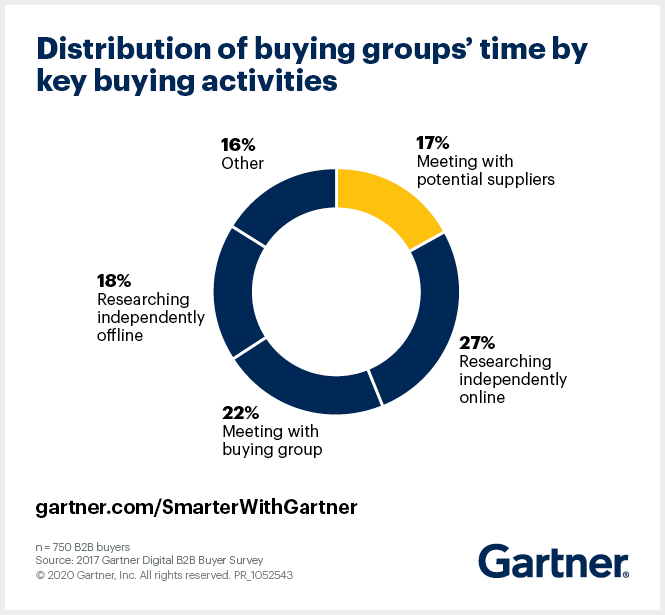- Learn
- The Onlinification Hub
- Is traditional B2B Sales obsolete?
Is traditional B2B Sales obsolete?

In response to the glaring disconnection between how suppliers attempt to sell and buyers' purchasing preferences, forward-thinking B2B enterprises are reshaping their operational models, whether this signifies the end of conventional B2B sales and marketing and heralds a new era of contemporary B2B purchasing.
Historically, B2B sales and marketing organisations have followed a linear or sequential operational pattern. Conventional digital marketing strategies engage potential customers at the onset of their purchasing journey by aligning their interests and facilitating sales engagement through digital content, automation, and lead nurturing.
Upon identifying marketing-qualified or sales-qualified leads, individual sales representatives are responsible for pursuing these prospects via in-person meetings or virtual communication.
This process culminates in a handover, where marketing passes the baton to sales, and digital customer interaction segues into face-to-face engagement. This remains unchanged even in sophisticated account-based marketing (ABM) strategies, perpetuating a system where marketing precedes sales.
In essence, large-scale digital interaction is followed by targeted sales representative interaction. The primary focus of the long-standing drive for sales and marketing integration has been the smooth progression of deals along this journey. This involves reducing friction, aligning data and metrics, and balancing incentives and reporting to transition from digital marketing to human selling seamlessly.
Even in more advanced ABM approaches, those linear physics remain predominantly unchallenged—first, the marketing department, then the sales department.
The emergence of digital B2B purchasing
The principal challenge of this traditional approach is that it needs to adapt to the modern digitally-dominated B2B buying behaviour, leaving much of the conventional commercial model outdated and nearing obsolescence.
A pre-pandemic survey by Gartner involving 750 B2B customer stakeholders in complex solution purchases revealed that these customers spent only 17% of their total buying time engaging directly with supplier sales teams.
Instead, the bulk of their purchasing activity involved independent online learning (27%), independent offline learning (18%), and building consensus among a variety of internal (22%) and external stakeholders (11%).

However, 17% of purchasing activity is devoted to virtual and in-person supplier interaction, which is spread across all suppliers, not just one. Suppose three suppliers are competing for the same opportunity. In that case, that time is divided equally, affording each sales team a slim chance to interact with the customer directly—perhaps a mere 5-6% of the total buying time.
This minuscule window of direct interaction poses a formidable challenge to many sales managers. It's frustrating that they need the traditional opportunity to significantly influence purchase deliberations and sway customer preference towards their unique offering. Given the modern B2B buying journey, supplier sales teams need more room for traditional selling.
The multi-touchpoint purchasing landscape
Today's B2B buyers extensively utilise digital data and information throughout their purchasing journey. For instance, in survey after survey, B2B buyers engaged in complex purchasing reports using digital tools, particularly supplier websites, nearly as frequently as they engage with sales reps to gather necessary information for various buying tasks, such as problem identification, solution exploration, requirement development, and supplier selection. Customers have become indifferent to where they source the information needed to advance purchase decisions.
For sales managers striving to regain customer access, the harsh reality is that customers rarely seek access to sellers. Previously, customers initiated sales conversations to acquire the information required for specific buying tasks. However, now that most of this information is readily available online, sales reps are no longer the main conduit to the customer but rather one of many potential channels. This has left many sales reps grappling to provide unique value that justifies the additional time and effort of person-to-person interactions.
Despite this struggle, there is a critical lesson for future commercial success: Assisting B2B buyers is not solely a sales challenge but an information and accessibility challenge. Companies that successfully deliver the most relevant information through their customers' preferred channels are better poised to succeed in a rapidly evolving commercial landscape.
A future free of sales rep interaction
B2B buyers express a strong preference for a sales rep-free purchasing experience. Both practical experience and data suggest an imminent and dramatic generational shift in customer engagement preferences.
Some commercial managers argue that complex solutions require collaborative customisation that necessitates human interaction, thus deeming sales reps "essential workers" in B2B buying.
However, most would concur that current B2B buying experiences need to be more sophisticated, nuanced, and advanced enough to support customers who prefer to purchase entirely independently.
The fact that today's customers can only purchase complex solutions with sales rep involvement does not mean they wouldn't prefer to do so if possible.
Suppliers and customers need to be more in sync regarding their interaction preferences. As a result, suppliers sell differently than many customers prefer to buy. This discrepancy exposes suppliers to the risk of competitors bridging the gap in more streamlined ways.
Restructuring your commercial engine
Changing buying behaviours necessitates organisational restructuring.
The sequential commercial engine, the once-valid proxy for underlying buying behaviour, must be more in sync with modern B2B buying patterns. In the current buying journey, there is no transition from digital to in-person or from marketing to sales.
B2Buyers exhibit channel-agnostic behaviour and strongly prefer digital methods.
Consequently, some customers may seek sales rep input to explore available solutions early, then return to digital channels to develop their requirements.
Later, as more stakeholders become involved, they may revisit or even rethink their initial problem, leading them to reevaluate or reconsider potential solutions, with or without sales rep involvement.
Merely aligning sales with marketing to ensure a seamless deal progression and purchasing process is an inadequate solution to a radically new buying reality.
Instead, you should understand your customers and provide them with the information they need at the right time.
The alternative is to overhaul your organisation and modus operandi completely.
Stay tuned to the Onlinification Hub for more insights like this. Be sure to subscribe; we'll notify you when new articles are ready.
Keep updated on thoughts, facts and knowledge!
Related
-
By Anders BjörklundThe three tiers of sales transformation: A comprehensive approach
-
By Tobias PasmaFighting churn by removing friction
-
By Anders BjörklundReimagining the modern B2B salesperson: Key attributes for success
-
By Anders BjörklundTransforming sales: The road to success and the pitfalls
-
By Tobias PasmaHow to enable your sales team when selling to a complex DMUs
-
By Anders BjörklundModern lead generation in B2B



